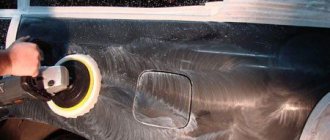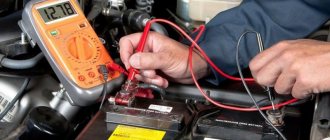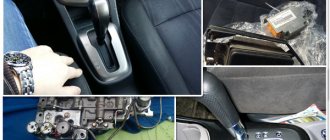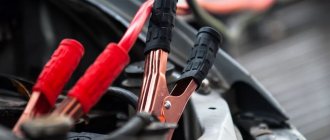To break in a car or not, all the pros and cons
Running in a new vehicle is a process during which proper grinding of all main units, components and parts occurs.
Most automakers carry out the so-called “cold” run-in before installation on the car, but this procedure is carried out in gentle modes, which are rarely achievable in a real situation. The machine is run in in a gentle manner, which cannot in any way worsen the condition of the components and parts. The opponents of running-in are mainly representatives of manufacturers, stating that modern cars do not require any restrictions in operation from the first kilometers, and all the necessary procedures were carried out at the factory (cold running-in).
https://www.youtube.com/watch?v=ytadvertiseru
Many manufacturers indicate certain restrictions on the operation of a new car; a number of them recommend undergoing zero maintenance.
General recommendations for running in a car on a gasoline engine for the first thousand kilometers - do not exceed the speed of 90 km/h, do not use high gear and the engine speed should be below 3300-3500 rpm. Then gradually increase the load (revolutions and use of top gear) and, by approximately 3,000 kilometers, your car will be able to realize its performance characteristics.
Breaking in a diesel engine is more difficult. During the first 1,500 kilometers, the revolutions should be below 2,500, but above 1,200. During break-in, it is not recommended to use idle speed, and during warm-up, the engine crankshaft speed should be kept at 1,200 rpm.
Only after running-in are these restrictions lifted. Diesel engines run in mileage two to three times longer than gasoline engines. After approximately 6,000 km, the car fully realizes its performance characteristics.
The running-in period is about 3000 km. It is during this period that the grinding in and running-in of new parts takes place.
Rules to follow during the first 3000 km:
- You cannot change oil that was filled at the factory.
- You should check your tire pressure before every trip.
- Do not allow the engine to operate at engine speeds exceeding 3000, and also drive for a long time at the same speeds. It is optimal to use the engine in the range from 2000 to 3000 rpm.
- Set the gear correctly.
- The running-in speed should be less than 100 km/h.
- Do not use fifth gear for the first 1500 km.
- Do not load the vehicle (do not tow other vehicles or trailers).
- Do not brake or accelerate sharply.
- Try not to let the engine idle.
During the break-in period, the main thing is not to overload the engine. It is better to spin the engine up to 4500 rpm with a minimum load than to drive loaded at 2000 rpm. At the same time, in the first 500 kilometers of the run you need to maintain a uniform movement (without jerks, sudden braking or sudden acceleration).
The speed should not be less than that indicated in the table.
| Broadcast. | Maximum speed. |
| First. | 25 km/h. |
| Second. | 40 km/h. |
| Third. | 60 km/h. |
| Fourth. | 90 km/h. |
| Fifth. | 115 km/h. Run-in of the car - the first 2500 km of operation. It is during this period that intensive breaking-in of parts occurs. |
When running in a new car, do not allow high engine speeds during the first thousand kilometers (for a diesel engine during the first 1,500 kilometers). Break-in with a gasoline engine lasts for the first 3,000 km, and with a diesel engine – 6,000 km.
- It is necessary to avoid running the engine at idle speed (800-900 rpm).
- In this case, you cannot engage fifth gear on a manual transmission (fourth gear on an automatic transmission).
- Try not to brake the engine.
- Before starting to drive, warm up the engine for several minutes at 1200-1500 rpm.
- When driving, keep the speed in the range of 2000-2500.
- Do not engage second gear until the engine is completely warm. In APKK you need to set the forced mode so that second gear is not engaged.
- Do not make sudden jerks when moving. As well as sudden acceleration or braking.
- Avoid city traffic if possible.
The ideal option for running in the engine would be the track. On the highway, do not shift above fourth gear and do not rev the engine above 3000 (the speed should be below 80 km/h). It is worth remembering that you must constantly (every 10.15 minutes) change the speed (in the range of 2000-3000 rpm). Approximately every 100 kilometers, check the engine oil level, as well as other fluids, especially for leaks (just look under the car).
The first few hundred kilometers are very important for a car.
Run-in stages
The question of whether a new engine needs to be broken in can only be asked by a layman. Of course it is needed. Full operation of the vehicle is possible only after proper running-in. It is better if the car is run in in several stages.
At the first stage, you need to drive 500 kilometers and see how the car behaves. The movement should be uniform so as to lightly load the transmission and power unit. This is not difficult to do - just drive outside the city limits and keep the speed around 50 km/h in 3rd gear. Then we switch to fourth gear, the speed increases to 70 km/h. In this mode you need to drive another 100-150 km.
Continue driving in fourth gear. Every hundred kilometers increase the speed by 10 km/h. At the final stage of the trip you need to reach 100 km/h. Don't go on hills and avoid aggressive driving. If you cannot do without “recklessness”, then it is better to drive in a lower gear - this way the car will bear the load more easily.
During the second stage of running-in, you need to drive 500 kilometers. Here the speed can be increased to 120 km/h. But it’s still better not to drive onto steep slopes. As a last resort, you can do this in 4th gear.
The next 500 kilometers must be covered in fifth gear. It is not advisable to move uphill. Increase the speed at this stage to 140 km/h.
At the fourth stage, the car must travel 2,000 kilometers. Here you can already take the climbs in fifth gear, but they should not be too steep. At the same time, do not raise the vehicle speed above 110 km/h.
The opinion that running-in is not necessary is erroneous. To protect parts from dry friction, a layer of protective film is needed. It is formed only at normal oil pressure - at 1,200 rpm.
When the engine system break-in is completed, the engine oil must be drained from the system. This is explained by the fact that it has accumulated a lot of metal elements left after assembling the car.
If the car is broken in in winter, other rules must be followed. Firstly, the engine must be properly warmed up before starting. The same goes for the gearbox. You can use a burner to warm it up. Once again, we remind you of the instructions, which explain in detail how long the car should be run in and under what conditions this procedure should be carried out.
If you strictly follow the instructions, you will definitely break in the car without harm to its components and structures. Proper running-in is a guarantee that the car will serve you for a long time and will not require serious and costly repairs.
Just as any purchased new thing “gets used” to its owner, so a car that has just been released from the factory must get used to the owner, and the driver to the car. Moreover, in the literal sense of the word, many parts of the machine will be worn in. The design of both impeccable foreign cars and domestic cars is based on the same principle. The entire car consists of a large number of so-called rubbing pairs - mutually rubbing parts. Therefore, any auto mechanic will tell you how important it is to first break in a new car under gentle conditions, take care of the engine, and only then proceed directly to operation. Perhaps some drivers don’t even know that the wheels of a new car first need to be driven for about 500 kilometers in order to “get used” to the rims, let alone other parts! Especially so that the friction force does not have such a detrimental effect on the mechanism, all kinds of oils were invented that envelop the parts with a special film and protect them from premature abrasion. But no matter how magical power engine oils have, they alone are not enough to protect a car. For a new machine, one of the important conditions for its further proper operation is its proper running-in. And even though managers and sellers of car dealerships unanimously assure that running-in is not required and the manufacturing plant has provided for this, it is still better to take care of your “iron horse” and drive 2000-3000 kilometers under certain conditions, than to later pay for your indiscretion with endless repairs. Experts advise following a number of simple recommendations for running in a new car with an automatic transmission, and then any trip will be pleasant and joyful. Try to avoid running the engine at constantly high or low speeds. Also, do not allow the engine to idle. Braking of a car with an automatic transmission in manual mode is undesirable. When driving around the city, you cannot avoid frequent sudden stops and jerks. This leads to rapid fuel consumption and also adversely affects the performance of the car. By the way, not only new ones. Before you start moving, you need to warm up the engine for several minutes (4-5 is enough) at low speeds of 1000-1200. In the automatic transmission, to warm up while driving, you need to set the mode to forced, which will not allow gear shifting beyond 2nd (with 4 automatic transmission) and 3rd (with 6 automatic transmission).
For running a car, the optimal speed is considered to be from 80 to 115 km/h. It would be nice to test your car on the track without accelerating or exceeding 3000 rpm. And again, the speed should not be constant; you need to change it every 10-15 minutes. Gasoline and oil levels need to be monitored every 100 kilometers. In general, make it a rule to check the fluid levels in your car every day. You can even look under the bottom to see if there are any traces of oil on the asphalt.
Regularly inspect the car in case of breakdown, look under the hood, check the tires. If you have to drive on busy city streets, try to press the pedals smoothly and monitor the speed - no higher than 2500 per minute. Take care of your car, do not accelerate sharply with the desire to check the promised speed result. An untested car will not be able to immediately achieve high results, and such experiments will not benefit it. When running in, you should remember one important point - you need to run in the car only on good roads; off-road conditions are not suitable for a new car. The first 500-1000 km. are so important for the engine, so be patient and you can soon achieve the desired results.
If you bought your first car, remember that running a new car in the winter is the best option. For many, purchasing their first and long-awaited car is the most joyful day in their lives. They prepare for it in advance, looking for a place for further storage. This is of course correct, but not the main thing. The length of its service life depends on how well the running-in is carried out.
Breaking in a new car in winter, why exactly? Moving components and assemblies in new vehicles work differently than in used ones. They have not yet had time to get used to, “find” their place, as a result of which the overall temperature of the engine increases, and production in the form of metal shavings appears in the oil. If everything is done incorrectly, this is minus 35% of the total engine life. The percentage is significant.
It is necessary to switch gears smoothly, without jerking, and this does not depend on the time of year. A clutch impact can damage the synchronizers, which will lead to urgent repairs. For diesel engines, the break-in rules are the same as for gasoline types. The only and main condition is to wait until the indicator on the instrument panel goes out. Some experts insist that the speed threshold for a diesel engine is slightly reduced, but manufacturers do not provide such information.
Whatever the car is, domestic or foreign, do not rush to drive it at first; it is better to drive it gently for 2000 km than to do a sudden overhaul later. If possible, buy a car in the cold season, since running in a new car in winter will be much more effective than in summer. As for other matters, let each owner decide for himself.
Breaking in a car is a very important stage in the life of every person who was able to realize his dream and purchase a new car. As a rule, such car owners are faced with a huge amount of advice from various “experts”, so it can be difficult to figure out exactly how to break in a car. We will look at really effective methods for breaking in a new car.
Myth #1 is that new cars simply don’t need to be broken in. But in reality, one should not forget about the laws of physics. All components that interact with each other must undergo some adaptation. If this point is not taken into account, the engine, gearbox and other components of the car may operate under too high loads. As a result, the service life of these elements will be significantly reduced. And the consumption of fuel, oil and other fuels and lubricants usually increases.
Some employees of car dealerships say that car manufacturers already perform “cold” running-in, so cars do not need a “hot” running-in (this is what will be discussed in our article). Unfortunately, everything is far from so simple. Although power units do undergo such a run-in at the factory, this is only one of the methods for detecting defects. Therefore, you should never forget about the “hot” run-in.
Zero maintenance, pros and cons, to pass or not?
https://www.youtube.com/watch?v=ytcopyrightru
During the operation of a new car, moving elements grind in, and chips can form in the engine, which get into the oil and oil filter. At zero maintenance, in addition to inter-interval oil changes, the levels of all working fluids are checked and, if necessary, replaced or topped up. They also carry out a quick inspection of the interior, body parts, electrical systems, and the condition of the chassis and brake systems.
None Changing the oil after running in the internal combustion engine can extend the life of the engine, since chips (if any) will be removed from the engine lubrication system, which will reduce the likelihood of scuffing and further destruction of components.
How to properly break in a new car
In order for the operation of a new car to be long-lasting and enjoyable, after purchase it is necessary to follow special rules for the first few thousand kilometers, allowing the main components and assemblies to go through the grinding-in process, which will ensure reliable service.
Russian roads are far from ideal, so at first you should avoid bumpy or field roads, especially in rainy weather and the off-season, this is a fundamental point.
How to properly prepare for breaking in a new car
A new car requires particularly careful monitoring of individual elements, since if a possible defect is detected untimely, the consequences will not be very pleasant.
More on the topic: Automatic transmission, manual transmission on Hyundai Solaris: fuel consumption, reviews
One of the main elements of the car is the engine, which requires particularly careful running-in, which is the key to good long-term operation even beyond the warranty, excellent dynamics, low fuel consumption and other parameters.
The most harmful to the engine are heavy loads, which involve driving in high gear at low speed and pressing the gas pedal hard (for example, driving in 5th gear at a speed not exceeding 70 km/h; driving uphill at low speeds (less than 2000), especially with the extra load.
Now about the driving style during break-in
The first thing the driver must remember is that you cannot press the gas pedal sharply, or press the brake pedal.
These actions will load the engine even more. And even more so, you don’t need to drive tight during break-in. Before the first trips, you should warm up the engine as best as possible, especially if it is cold and frosty weather. All of the above should be done on smooth roads (preferably a highway), and not during rush hour or on broken roads. If you have a used car in your hands, and when the mileage shows three to five thousand kilometers on the meter, then this is the first sign that you need to change filters, engine oil and conduct a full technical inspection. But, if the inspection did not reveal any deviations or breakdowns, then we can safely say that the car has been run-in.
As for used cars, it’s worth taking a closer look and listening to the engine and chassis during break-in, if they were taken from hands you don’t know. Such a car is much better in its operating and technical characteristics than a new one. The engine uses less fuel and oil during operation than a completely new one, it responds faster to the gas pedal, but it’s still better to check the oil level more often and take a closer look at the operation of the piston and valves, so it’s worth running in a new engine in your own way.
Running in the transmission
The transmission is the second most important unit in a car. Its structure is very complex, it has many moving and rubbing elements, so you should be meticulous in running the box. Careful running-in of the transmission will extend its uninterrupted service life and postpone costly repairs for a considerable period.
To grind in the friction linings, you need to smoothly switch gearbox speeds.
During the running-in period of the vehicle, it is prohibited to operate it off-road. It is also not recommended to connect the front axle during the first 500 kilometers. During the first 1000 km, you should not tow another car or trailer. To ensure proper “grinding in” of the pads to the discs, sudden braking should be avoided.
Features of running in with an automatic transmission
An automatic transmission is an extremely complex mechanism that requires careful handling and careful running. It’s better to wait a little, drive off wisely, than then shell out for expensive repairs, which, of course, will happen after the warranty expires.
Recommendation for running in an automatic transmission:
- before driving, the automatic transmission should be warmed up to operating temperature so that the transmission fluid reaches the desired consistency; in winter this can take up to 10 minutes;
- It is strictly forbidden to use the kickdown mode;
- make sure that the neutral mode does not turn on while driving, which can happen due to a decrease in the pressure of the transmission fluid when it heats up, causing pressure on the planetary unit;
- avoid wheel slipping;
- It is strongly recommended to test the automatic transmission outside the city to avoid rough driving conditions;
- avoid transporting heavy objects or large numbers of passengers;
- Avoid overheating of the automatic transmission in every possible way during the first 500 kilometers due to the fact that the upper layers of the friction discs, hydraulic transformer and other parts of the planetary assembly are being rolled in;
- if the automatic transmission is serviceable, i.e. provides for the replacement of transmission fluid, it would not be superfluous to replace the working fluid to remove possible chips or other foreign components from it.
There are no special features for running in an automatic transmission, but there are several points worth paying attention to:
- Do not engage high gear (usually fourth).
- Do not use neutral gear when driving.
- Drive it outside the city, because when driving in traffic jams you can “kill” the transmission.
- Change the oil in the gearbox after a run of 1000-2000 km.
During and after breaking in the car
Running in a new car with an automatic transmission involves monitoring the condition of the gearbox. First of all, an automatic transmission requires more careful handling than a manual one (this is a question). This is especially true for running in a new car in winter, when sub-zero temperatures affect the condition of the oil in the automatic transmission. Before driving in winter, a car with an automatic transmission must be thoroughly warmed up to engine operating temperature.
The oil level, as well as other fluids, needs to be checked regularly. Also check the bottom of the car, nothing should be leaking. This will make it possible to identify defects at their initial stage. Remember that proper break-in extends the life of the transmission and engine, making their operation reliable and economical.
If the engine runs out of oil and you are still using it, this may lead to the need to replace the engine, which is an expensive and dubious “pleasure”. The oil level should be checked when your car is on level ground. When checking the level, you need to wait five minutes after the engine stops and then check what the oil level is. If it is almost at a minimum, then it needs to be topped up. Be careful when choosing oil; it must be of good quality and the same grade.
After 1000 km, you should go to a car service center and undergo a technical inspection. There you can find out the condition of your car and clarify everything you consider necessary. This will make it possible to properly complete the break-in of the car. In fact, the rules are simple. If you follow them, the vehicle will not let you down! We hope our tips on how to properly break in a new car helped. Come on!
New cars shine and look perfect. They are ready for long trips, but to minimize the risk of breakage of moving parts and to increase their service life, the parts must be ground in. The car needs to be run-in.
Now cars are no longer unpretentious. For them to work fully, an initial run is needed. It should be carried out competently, in compliance with all established rules.
Manual transmission
None Tips for properly breaking in a manual transmission:
- it is necessary to start moving and pick up speed smoothly, changing steps in a timely manner;
- It is necessary to engage the gears in the manual transmission smoothly with the clutch pedal fully depressed, avoiding sudden movements or applying significant force;
- during the first thousand kilometers, it is recommended not to travel at speeds exceeding 80-90 km/h and in higher gears (4,5,6);
- it is necessary to change the stages one by one and in a timely manner; when running in, it is strictly not recommended to jump over speeds (for example, from 4th to 2nd, from 3rd to 5th);
- during running-in, it is necessary to use a smooth ride mode, if possible avoid long climbs or travel on roads with poor surfaces;
- After finishing the break-in of the manual transmission, it would not be superfluous to completely replace the working fluid in it to remove metal shavings or other foreign substances that could have formed during the grinding of manual transmission components.
A new car requires careful handling and proper operation, especially during the first thousand kilometers, during which grinding in of various parts and components occurs.
The break-in procedure is simple, but its correct implementation will extend the life of the main components and help avoid numerous breakdowns. The main principles of break-in are daily monitoring of working fluids and avoiding loads on the internal combustion engine and transmission, for which you should follow the simple recommendations described above.
More on the topic: Changing the oil in automatic and manual transmissions of Hyundai Solaris
We'll tell you what breaking in a car is and how to properly break in a new car engine, which is worth remembering.
Running in a car has been a forgotten concept since the times of the USSR. At the same time, technical books indicated the rules for correct running-in and the number of required revolutions. But that's all in the past. Now we are in the 21st century, which means that the automotive industry is not “standing still.”
Running in a car is the first movement of the car, on which future operation as a whole depends. Since progress has taken its toll, today, after assembling the entire passenger car, its parts under the hood can be run in both hot and cold. Most car enthusiasts believe that hot and cold running-in at production is more than enough. Although, we can safely say that the main part of the car in this process is not only the engine.
In general, it is mandatory to break in a car after purchasing it at a car dealership or after major repairs, since no one knows how to properly break in a car at the factory. All its smallest elements must work flawlessly and as a whole. Therefore, if there is an opportunity to test the newly made “iron horse”, then it is advisable to do so. Try to adhere to the basic rules of running in.
The first rule for good engine performance is well-ground parts. Engine piston rings and valves require special attention. And in general, all other elements should not remain in the background during inspection.
At first, when running in, you will feel that the engine is a little dull, and the declared power is not at all the same. But over time, after grinding in all the parts, the power will increase, and it becomes playful and quickly responds to the gas pedal. Therefore, nothing else needs running in like a car engine.
Also, do not forget about the brake mechanism during break-in. The pads should rub under the discs. If you adhere to this, you can achieve efficiency and long-term performance from pads and discs.
https://www.youtube.com/watch?v=ytpressru
The transmission is not the last place in running-in and inspection. Even regardless of what gearbox is installed in the car, manual or automatic. The first run-in of a car is a kind of familiarization.
During running-in and further driving you need to “feel” it. This is done in order to prevent, or, in extreme cases, to notice problems from which no one is immune.
The first thing the driver must remember is that you cannot press the gas pedal sharply, or press the brake pedal. These actions will load the engine even more. And even more so, you don’t need to drive tight during break-in.
Before the first trips, you should warm up the engine as best as possible, especially if it is cold and frosty weather. All of the above should be done on smooth roads (preferably a highway), and not during rush hour or on broken roads. If you have a used car in your hands, and when the mileage shows three to five thousand kilometers on the meter, then this is the first sign that you need to change filters, engine oil and conduct a full technical inspection.
As for used cars, it’s worth taking a closer look and listening to the engine and chassis during break-in, if they were taken from hands you don’t know. Such a car is much better in its operating and technical characteristics than a new one. The engine uses less fuel and oil during operation than a completely new one, it responds faster to the gas pedal, but it’s still better to check the oil level more often and take a closer look at the operation of the piston and valves, so it’s worth running in a new engine in your own way.
The most important part of running a car is the first 200 kilometers of engine operation. For break-in, you should choose a quiet place that is not overloaded with cars, in case the car enthusiast lives in a noisy metropolis. When the car has moved, it is then that it is necessary to monitor the engine speed.
During the first run-in, the number of revolutions should be no more than 2500 rpm. The first test run-in process has five stages.
First stage: the driver must drive the car at a speed of 40-50 km/h for the first 50 km; this running-in is the most important, since the quality of engine operation in the future will depend on it. Second stage: for the next 100 km, the speedometer speed is allowed to be somewhere around 60/70 km/h. Third stage: for the next 100 kilometers you need to drive at a speed of approximately 70-80 km/h, without overloading the engine with high speeds.
The fourth stage: again you need to drive 100 kilometers, but at a speed of 90 km/h. Fifth stage: acceleration over 90 km/h is allowed, it is advisable to look at the temperature of the car engine and stop after a short distance and let the engine cool.
Passed the first test. After the first break-in of the car, you should not postpone the second break-in for a long time. To do this, you need to dial 2500 rpm with the engine well warmed up, and also occasionally increase the engine speed to 3000.
More on the topic: Tires for Hyundai Solaris: how to choose, sizes, pressure
If you are driving on a flat road, or from a mountain (but not up a mountain), then you can accelerate the car no more than 100 km/h and, by releasing it into neutral, let it drive without load, thus you will hear whether the engine is running evenly and Is there any knocking noise in the chassis of the car?
In addition to the engine, there are some other parts that require wiping during a good break-in:
- Chassis. It, in turn, consists of struts, hubs, wheels, springs, bearings in the hubs, stabilizer bars, suspension arms and ball joints. These elements require running-in; after a while they need to be inspected before or after running-in. They can only wear out over time during prolonged use.
- Steering. This control consists of a steering wheel, a steering column mechanism, steering rods, a steering rack with power steering, steering tips and swing arms. These parts do not require inspection during break-in. You just need to inspect them after a long time of operation. When worn out they should be replaced.
- Transmission. The gearbox includes the following elements: connecting link, clutch (there are both hydraulic and cable). When the vehicle is run in, the clutch disc is ground in on both sides of the drive and driven discs. As for the constant velocity joint, it can only wear out during long-term operation.
- Anti-lock braking system. It consists of: working cylinders, brake drums, brake discs and a handbrake drive. There is no need to break in anything from this list except the brake discs, which need to be slightly rubbed into each other. Everything else on this list only wears out during long-term use of the car.
There is nothing complicated in the process of running in the “iron friend”. The main thing is to remember the basic rules of breaking in and, of course, stick to them. Video about how to properly break in a new car: Tags.
https://www.youtube.com/watch?v=ytcreatorsru
Advice for motorists.
Proper car break-in
- First of all, we advise you to forget about the speed capabilities of your iron friend. You need to protect the car from loads during the first 1-1.5 thousand kilometers. All driver actions must be as smooth as possible. This is exactly the point of running in.
- New engines do not like prolonged operation in a certain crankshaft speed range. For this reason, it is not recommended to drive at a stable speed for very long during break-in. At the same time, do not forget about gentle operation of the engine. It is necessary to find something between stable speed and sudden acceleration/braking.
- Most engines are recommended to be used in the range of 2-4 thousand rpm. Experience shows that it is in this range that you can achieve minimum fuel consumption. It is also undesirable to accelerate in high gear when the tachometer needle drops below the 2000 rpm mark. This mode of engine operation cannot be called gentle.
- Engine braking or prolonged idling of the engine are not conducive to proper break-in of a new vehicle. You shouldn’t carry too much luggage in your car, and you shouldn’t drive to the country with a trailer for the first thousand kilometers either. The fact is that if an unforeseen situation arises (for example, you can get stuck in the mud), you will have to seriously load the engine and gearbox.
- Check the amount of oil and other liquids regularly. Periodically look under the car to detect leaks in a timely manner. Thanks to this, you can avoid unnecessary costs for repairing various car systems. It is advisable to carry a bottle of motor oil with you in the trunk so that you can top it up if necessary.
- Checking the oil level should be done a few minutes after stopping the engine. The machine must be on as level a surface as possible, otherwise the measurements will be inaccurate. You need to pull out the oil dipstick, wipe it with a piece of cloth, and insert it back. Then the dipstick must be pulled out again (after a few seconds). The dipstick has MIN and MAX marks. If the level drops to the MIN mark, add oil. The distance between the above marks corresponds to 1 liter of oil. After adding, the oil level should not exceed the maximum mark.
- Breaking in a car involves more than just running in the engine. The remaining nodes are no less important. For example, you need to take care of a manual transmission. Do not release the clutch pedal too quickly. All elements of the gearbox must rub together well.
Don’t forget about undergoing “zero maintenance”. The car dealership should provide you with specific information about when exactly you need to come to the dealer. This is a very important procedure that helps to timely detect various defects and eliminate them. Specialists also check the condition of various liquids.
Mileage 500-1000
For the first 50 kilometers it is better to drive in third gear at a speed of 40-50 km/h. Then you switch to fourth gear and accelerate to 60-70 km/h. At this speed you need to drive 100-150 kilometers. Then, every 100 kilometers you need to increase the speed by 10 km/h, but at the same time remain in fourth gear.
It is necessary to avoid sudden acceleration, and also reduce gear and speed when driving uphill.
| Broadcast. | Maximum recommended speed. |
| First. | 20 km/h. |
| Second. | 40 km/h. |
| Third. | 50 km/h. |
| Fourth. | 80-90 km/h. |
Now you can use fifth gear at speeds over 100 km/h. But movement is only possible on horizontal sections or “downhill”.
| Broadcast. | Maximum recommended speed. |
| First. | 25 km/h. |
| Second. | 45 km/h. |
| Third. | 70 km/h. |
| Fourth. | 95 km/h. |
| Fifth. | 110-120 km/h. |
https://www.youtube.com/watch?v=ytpolicyandsafetyru
Now you can increase the engine speed to 3500.
| Broadcast. | Maximum recommended speed. |
| First. | 30 km/h. |
| Second. | 55 km/h. |
| Third. | 75 km/h. |
| Fourth. | 110 km/h. |
| Fifth. | 130-140 km/h. |
During this break-in period, you can gradually load the engine. When accelerating, the speed can be up to 4000.
| Broadcast. | Maximum recommended speed. |
| First. | 35 km/h. |
| Second. | 60 km/h. |
| Third. | 90 km/h. |
| Fourth. | 120 km/h. |
| Fifth. | 155-160 km/h. |
More about Solaris
- What kind of gearbox does Hyundai Solaris – Taxi Bolt have?
- What kind of gearbox does Hyundai Solaris – Taxi Bolt have?
- Hyundai Solaris sedan colors - current palette of the Hyundai Solaris Sedan
- What kind of gearbox does Hyundai Solaris – Taxi Bolt have?
- What kind of gearbox does Hyundai Solaris – Taxi Bolt have?
- What kind of gearbox does Hyundai Solaris – Taxi Bolt have?
- What kind of gearbox does Hyundai Solaris – Taxi Bolt have?
- How to check a car's paintwork with a thickness gauge when buying a car secondhand || What is the thickness of the paint on a Solaris car?
- Hyundai Solaris. It's like watching...
- General information about the Hyundai Solaris











